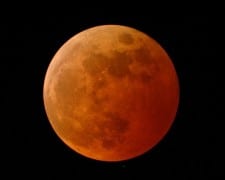Crimson Moon Captivates Viewers
 Through the Robinson Observatory “Knights Under the Stars” free event series, an early-morning April 15th Lunar Eclipse viewing drew the attention of hundreds to UCF Memory Mall. The Robinson Observatory provided the telescopes for this special occasion and the event was made possible through the help of volunteers from the Astronomy Society as well as the physics department. Their help was critical to the success of the event. This total eclipse was visible to everyone in North and South America.
Through the Robinson Observatory “Knights Under the Stars” free event series, an early-morning April 15th Lunar Eclipse viewing drew the attention of hundreds to UCF Memory Mall. The Robinson Observatory provided the telescopes for this special occasion and the event was made possible through the help of volunteers from the Astronomy Society as well as the physics department. Their help was critical to the success of the event. This total eclipse was visible to everyone in North and South America.
The event took place from 2:30am to 5:00am, with the eclipse being visible from approximately 2:00am to 5:30am.
To see a video from this event, click here.
“This is many more people than we were expecting,” UCF graduate student in planetary sciences, Nate Lust proclaims. “It’s really heartening to see this many people taking an interest in science, astronomy, and just generally getting involved with UCF.”
As this rare visual opportunity made its spotlight in the night sky, viewers also had the chance to sneak a peek of both Mars and Saturn – with Mars at its brightest in more than six years.
A total lunar eclipse occurs when the Moon completely enters into the darkest part of Earth’s shadow. This can only happen when the Moon is on the exact opposite side of the sky to where the Sun is — in other words, when the Moon is full. However because of variations in the Moon’s orbit we don’t get this eclipse at every full Moon. Interestingly, once the Moon is shadowed, instead of turning completely black, the Moon looks red. Even though Earth is completely blocking the Sun as seen from the Moon, some sunlight is refracted by Earth’s atmosphere and actually does still make it to the Moon.
For the same reason that sunsets and sunrises on Earth are red, the red light is what makes it around Earth to the Moon. Since only red sunlight is illuminating the Moon during the total part of the eclipse, we see it as red. Some called this total lunar eclipse a ‘blood moon’, but the term means different things to different people and does not have any accepted astronomical definition. All total lunar eclipses show a red Moon that looks blood-colored to some.
What is somewhat unusual is that this total eclipse was the first in a sequence of four straight total lunar eclipses. Usually a sequence of four lunar eclipses has some combination of total and partial ones; four straight total eclipses hasn’t happened since 1985/1986, and before the 20th Century there hadn’t been any since 1580/1581.
In Florida, we will have the opportunity to see two more out of this set of four total eclipses.
- The October 8, 2014, total eclipse will be visible although it will be trickier to watch since the Moon will be low, near the western horizon.
- The April 4, 2015, total eclipse will not be visible from Florida.
- The September 27, 2015, total eclipse will be visible and will occur late that evening.
“We’re looking forward to these eclipses, and Robinson Observatory will put on more of these events for the UCF community and the general public,” said observatory director Prof. Yan Fernandez. “We’re always looking for good excuses to show off the night sky!”
